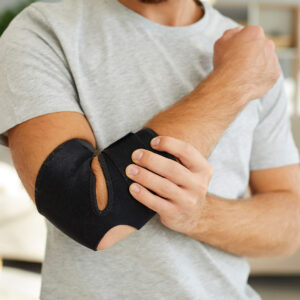Understanding Dislocated Elbows: A Guide to Prevention, Treatment, and Recovery

According to the National Library of Medicine, elbow dislocations are the second-most common joint displacement injury in adults and it’s the most common dislocation in children. Fortunately, there are ways to prevent a dislocated elbow, and if you do experience one, treatment is usually straightforward.
Dr. Dana Cruz, a fellowship-trained hand and upper extremity specialist at Orlin & Cohen, provides expert insights and tips for preventing, treating, and recovering from elbow dislocations. In this guide, she explains everything you need to know, including occurrences in children—helping you and your loved ones stay active, healthy, and injury free.
How to Prevent Elbow Dislocation
Sudden movements that forcefully displace the elbow bones, including the humerus, ulna, and radius, from their natural position can lead to a dislocated elbow. These injuries commonly occur during falls onto an outstretched arm, collisions in high-contact sports, forceful twisting, and other traumatic incidents. Thankfully, there are ways to reduce your risk of injury. Learn more about how you can prevent an elbow dislocation.
Wear appropriate sports gear
While sports and physical activities offer numerous rewards, they also carry inherent risks, particularly for joint injuries like dislocated elbows. To reduce your risk of dislocated elbows in sports, using appropriate protective equipment is crucial.
Protective gear acts as a shield against impacts, effectively distributing force and reducing the likelihood of joint injuries. Various forms of support are available to protect your elbows, including elbow pads, compression sleeves, and arm guards. These options offer cushioning, support, and stability to safeguard against potential injuries.
Strengthen your muscles
Improving the strength of supporting muscles around the joint can help prevent elbow dislocations. Key muscle groups and exercises you should consider include:
- Forearm muscles: Wrist curls and reverse wrist curls strengthen wrist extensor and flexor muscles.
- Bicep and tricep muscles: Bicep curls and tricep dips can improve elbow strength and your range of motion.
Avoid overexertion
Overexertion can arise when you push yourself excessively during training, potentially leading to fatigue, injury, or burnout. While challenging yourself is part of building endurance, it’s crucial to recognize the importance of gradual progression. Increase the intensity of your workouts over time and give your body time to adapt, minimizing the risk of overexertion and maximizing your long-term gains in strength and stamina. Read more about reducing your risk of sports-related injuries.
Understanding and Preventing Elbow Dislocation in Children (Nursemaid’s Elbow)
In children aged two to five years old, a common injury known as nursemaid’s elbow can occur when a child’s forearm is abruptly pulled or jerked, causing the radius bone to slip slightly from the ligament at the elbow joint. While nursemaid’s elbow involves a partial displacement rather than a complete dislocation, it is important to address it promptly.
These partial dislocations can occur with minimal stress, like a quick tug on the arm when it’s straight. Children suffering from nursemaid’s elbow frequently hold onto the injured arm and resist turning it.
In most cases, treatment is straightforward, and a pediatric orthopedist applies gentle pressure to realign the bones. Once the bones are back in place, recovery time is relatively short, and most children quickly regain their range of motion. Fortunately, injury recurrence is low, and there are preventive measures you can take to reduce a child’s risk of elbow dislocation.
Avoid pulling or lifting children by their hands and wrists
During early childhood, muscles and ligaments crucial for joint stability are still developing. You should avoid pulling or tugging a child’s arm and never lift them by their hands or wrists. Instead, place your hands under their arms or around their core to pick them up.
Avoid swinging by arms
Swinging your child by the arms can be an exhilarating experience for them. However, it can pose risks because a child’s musculoskeletal system is not fully developed until the later stages of adolescence.
Elbow Dislocation Treatment
If you suspect you or your child has a dislocated elbow, you should seek immediate medical attention. While most displacements do not require surgery, some include bone fractures. X-rays will help with the initial diagnosis and guide subsequent treatment.
While you should always listen to the guidance of your orthopedic specialist, the tips below may help enhance your recovery and reduce your risk of re-injury.
Cold therapy and heat application
When recovering from an injury, using ice and heat can be beneficial. This dynamic duo will aid in your recovery, and each plays a crucial role during different stages of your healing process.
Initially, ice constricts blood vessels, helping to reduce pain and swelling. Apply ice for 15–20 minutes every hour for relief.
Once the swelling has gone down, applying heat to the injury can boost blood circulation, transporting nutrients and oxygen to injured tissues. This promotes tissue repair and reduces stiffness. Apply heat for 20–30 minutes several times a day.
Activity modification
With a dislocated elbow, modifying activities is essential for recovery. Avoid movements that strain or stress the injured joint. Opt for low-impact exercises, like walking, that don’t burden the impacted area.
Immobilization
Immobilizing the dislocated elbow with a sling or splint during the early stages of your recovery prevents unwanted movement. Follow your healthcare professional’s guidance on usage and duration, transitioning to controlled movement exercises as the joint heals.
Physical therapy
Working with a certified physical therapist is pivotal to recovering from a dislocated elbow and can help reduce the risk of future injury. Your orthopedist and physical therapist will work together to create a personalized rehabilitation plan that gradually reintroduces movement and functionality. Exercises focused on improving range of motion and muscle activation are the basis of most therapy sessions.
As your recovery advances, you’ll strengthen the muscles surrounding the injured elbow joint. With your therapist’s guidance, you’ll progress through a series of exercises with gradually increasing resistance. This increased strength will help stabilize and protect the joint, helping to prevent future injuries.
A dislocated elbow may briefly interrupt your routine, but it doesn’t have to derail your goals. If you’re struggling to recover from or dealing with pain from a dislocated elbow, we’ve got specialists for that. Orlin & Cohen’s team features some of the nation’s best orthopedic doctors, including fellowship-trained elbow specialists, who can help you feel better, faster. Request a same-day appointment.



